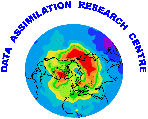About us
A brief history of DARC
DARC was founded as a NERC Centre of Excellence in the early 2000s under the directorship of Prof. Alan O’Neill. It was run from the Department of Meteorology at the University of Reading in the UK. The centre included personnel from the Departments of Meteorology and Mathematics, and the ESSC at Reading, and from RAL, BADC, and the Universities of Cambridge, Edinburgh, Oxford, Surrey, and Leeds. Its main remit was to use data assimilation to exploit measurements of the Earth from the new EnviSat research satellite launched in 2002. Some preliminary work on this was done previously by the EU-funded research project DARE. The work of DARC built on the Met Office’s assimilation and forecasting system, which included physics and chemistry processes in the Earth’s stratosphere. The centre was also active in developing new and improved data assimilation and satellite retrieval techniques. Previous centre directors (in chronological order) were Prof. Alan O’Neill, Prof. Martin Ehrendorfer, Prof. Peter Jan van Leeuven, and Prof. Alberto Carrassi.
NERC: Natural Environment Research Council
ESSC: Environmental System Science Centre1
RAL: Rutherford Appleton Laboratory
BADC: British Atmospheric Data Centre
DARE: Data Assimilation in Readiness for EnviSat2
Today
Today DARC is an active research group in the School of Mathematical, Physical and Computational Sciences at the University of Reading. It is comprised of many dozen research scientists. The group is lead jointly by Prof. Sarah Dance and Prof. Amos Lawless. It is not funded directly, although many of our research projects are funded by NERC, EPSRC, and the EU.
Our identity over the years



1 ESSC is now part of the Dept. of Meteorology, Univ. of Reading.
2 Do not confuse with an earlier project that also have the acronym DARE (Data Assimilation in Readiness for EnviSat).
